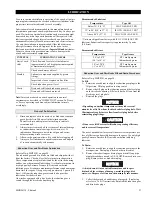
MHD56114 - Edition 4
13
Mufflers
Make sure mufflers are installed in winch exhaust manifold and
control valve exhaust port. An additional muffler is used on
winches equipped with an emergency stop and overload device.
Check mufflers periodically to ensure they are functioning
correctly.
Motor
For optimum performance and maximum durability of parts,
provide a lubricated air supply of 700 scfm (20 cu. m/min) at 90
psig (6.3 bar/630 kPa). Recommended pressures and volumes are
measured at the point of entry to the air motor directional control
valve.
Emergency Stop and Overload System
Refer to Dwg. MHP2434 on page 54.
Air supply line is connected to air control valve. When emergency
stop or overload valve is activated, all winch movement will stop.
CAUTION
• If winch continues to move (payout load) after emergency
stop activates, brake(s) are not holding load and may require
adjustment or repair.
When control valve senses a preset pressure difference between
ports, a pilot signal is sent to stop flow of air, all winch movement
will stop.
Initial Winch Operating Checks
Winches are tested for proper operation prior to leaving the
factory. Before the winch is placed into service the following
initial operating checks should be performed.
1.
When first running the motor inject some light oil into the
inlet connection to provide initial lubrication.
2.
When first operating the winch it is recommended that the
motor be driven slowly in both directions for a few minutes.
For winches that have been in storage the following start-up
procedures are required.
1.
Give the winch an inspection conforming to the requirements of
“Winches Not in Regular Use” in the “INSPECTION” section.
2.
Pour a small amount of ISO VG 32 (SAE 10W) oil in the
motor inlet port.
3.
Operate the motor for 10 seconds in both directions to flush
out any impurities.
4.
Check to ensure oil levels are “full”.
5.
The winch is now ready for normal use.





























